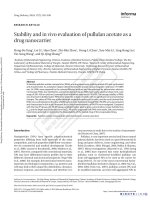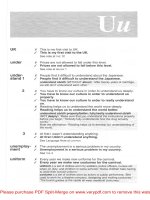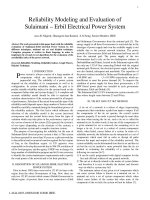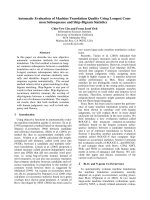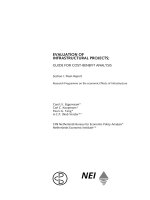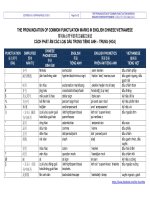Echocardiographic evaluation of common atrioventricular canal defects congenital cardiac anesthesi
Bạn đang xem bản rút gọn của tài liệu. Xem và tải ngay bản đầy đủ của tài liệu tại đây (1.74 MB, 39 trang )
LOG IN TO MY ACCOUNT
Search this website
!"
ABOUT
MEETINGS
EDUCATION
MEMBERSHIP
STS-CCAS DATABASE
NEWSLETTERS
LINKS
ADVANCED TRAINING
FOR PATIENTS & PARENTS
SPONSOR A MEMBER
Echocardiographic
Evaluation of Common
Atrioventricular Canal
Defects
Authors
Nelson Burbano, MD
Clinical Instructor in Cardiac Anesthesia, Harvard Medical School
Department of Anesthesiology, Pain and Perioperative Medicine
Boston Children’s Hospital and Brigham and Women’s Hospital
James A. DiNardo, M.D.,FAAP
Professor of Anaesthesia
Harvard Medical School
Chief, Division of Cardiac Anesthesia
Francis X. McGowan, Jr., M.D. Chair in Cardiac Anesthesia
Boston Children’s Hospital
1. Definition
There is variability in the terminology used to describe these defects
(name, definition and classification) depending mainly on the nomenclature
system that is utilized (“Van Praaghian” or “Andersonian,” Table 1).
Common atrioventricular canal (CAVC) is also referred to as
atrioventricular septal defect, common atrioventricular orifice,
atrioventricularis communis and endocardial cushion defect. [1, 2]
After integrating both Dr. Van Praagh and Dr. Anderson’s approaches,
CAVC can be understood as a group of cardiac defects due to deficiency
of structures derived from the endocardial cushions (atrioventricular
septum and septal aspect of the leaflets of the mitral and tricuspid valves),
characterized morphologically by a single atrioventricular junction or
connection and a common atrioventricular valve (AVV) with one or two
atrioventricular orifices.
2. Anatomy
Structures derived from the endocardial cushions during embryogenesis
include (Figure1): [1, 3]
Atrioventricular septum. This has two components, atrial and
ventricular.
Atrial component of the atrioventricular septum or canal
portion of the atrial septum. This is the portion of the atrial
septum located between the anterior-inferior margin of the
fossa ovalis and the common AVV. It results from a growth of
endocardial cushion tissue toward the posterior wall of the
common atria (it is not septum primum!). The absence of this
component results in an ostium primum atrial septal defect
(ASD).
Ventricular component of the atrioventricular septum, canal
portion of ventricular septum or inlet septum. This is the
muscular tissue that lies posterior immediately under the septal
leaflet of the tricuspid valve (TV) extending anteriorly into the
vicinity of the membranous septum. It results from a growth of
endocardial cushion tissue toward the apex of the heart. The
absence of this component gives the ventricular septum a
“scooped-out” appearance and results in a ventricular septal
defect (VSD) of the AV canal type (also inlet or posterior VSD).
There may be a variable degree of underdevelopment of the
inlet septum, so the VSD component of the canal can range
from small and restrictive to large and unrestrictive.[4]
Septal aspect of the leaflets of the tricuspid and mitral valves.
These result from the growth of endocardial cushion tissue toward
the lateral (right and left) aspect of the annulus of the common AVV.
As compared to a normal heart, the tissue deficiency at this level
results in an abnormal division or “clefts” of the septal leaflets of the
common AVV where the septal components of the two valves fuse
to form a separate superior common leaflet (superior bridging) and
an inferior common leaflet (inferior bridging).
There are major abnormalities in the morphology of the base of the heart in
CAVC that are not limited to the atrioventricular valves alone [2, 5]. The
common AVV is characterized by having a single atrioventricular junction
or connection (single fibrous AV annulus), a left component (mitral valve in
the normal heart), a right component (tricuspid valve in the normal heart),
and typically five leaflets (although the number of leaflets is variable – a
superior bridging leaflet, an inferior bridging leaflet, a left mural leaflet and
two right mural leaflets). The superior and inferior bridging leaflets cross
from side to side over the crest of the ventricular septum, and their
morphology and attachments vary. The presence of a large, single, ovalshaped AV annulus dislodges the aortic valve annulus from its normal
“wedged” position between the annuli of the TV and MV (Figures 2 and 3).
The anterior and superior displacement of the aortic valve by the common
AVV makes the outlet dimension of the LV greater than the inlet dimension
and elongates the left ventricular outflow tract (LVOT, Figure 4). This
anatomic abnormality is partially responsible for the characteristic
“gooseneck deformity” initially described in the left ventriculogram but also
appreciated in echocardiography.
3. Van Praagh Classification of CAVC [1]
Partial (Figures 5 and 6, Videos 2, 3, 4, 5, 6, 7, 8). This form of
CAVC is characterized by a large interatrial communication in the
canal portion of the atrial septum (ostium primum ASD), a “cleft” in
the left component of the common AVV (anterior mitral leaflet of the
MV in the normal heart) and abnormal elongation of the LVOT. As in
other forms of CAVC, there is a single AV annulus and a common
AVV with two AV orifices and with left and right components that
share a common hinge point at the crux of the heart. Although there
is a variable degree of deficiency in the ventricular component of the
AV septum, this is completely closed by a tongue of connective
tissue composed of AVV tissue and chords attached to the crest of
the ventricular septum, such that no interventricular communication
exits. The abnormal implantation of the “common hinge point” of the
septal aspect of the right and left components of the common AVV
(septal leaflet of the TV and anterior mitral leaflet of the MV in the
normal heart) is a consequence of the deficiency of the ventricular
septum. Abnormal elongation of the LVOT is seen in this and other
forms of CAVC and constitutes a risk factor for LVOT obstruction,
especially when there are chordal attachments from the left
component of the superior bridging leaflet to the ventricular septum.
In the opinion of some experts, the tissue deficiency in the septal
aspect of the right and left components of the common AVV does
not represent real “clefts,” but rather a defect in the zones of
apposition between the superior and inferior bridging leaflets at the
ventricular septum. Typically this is the site of origin of AVV
regurgitation (Videos 4, 5, 6, 7, 8). Echocardiographically, there is a
clear difference between this defect and the isolated cleft of the
anterior mitral leaflet of the MV seen in the adult population. In the
later, the cleft most frequently extends along the mid point of the
anterior mitral leaflet (A2) towards the aortic valve. In CAVC on the
other hand, the “cleft” extends from the mid point of the “potential
anterior mitral leaflet” towards the atrial septum (from A2 to the
posteromedial commissure). This and the intermediate form of CAVC
are the only two lesions where the common AVV has two orifices.
Transitional (Figure 7 and 3, Video 13, 14, 15, 16, 17). This form of
CAVC is characterized by a large interatrial communication in the
canal portion of the atrial septum (ostium primum ASD) and a
pressure restrictive interventricular communication in the canal
portion of the ventricular septum (inlet VSD). Typically there are
multiple short, dense chord attachments from the crest of the
ventricular septum to the undersurface of the superior and inferior
common leaflets of the common AVV and multiple small shunts
through these attachments and the septum. Other important
features of the transitional form of CAVC include single AV junction or
connection, common AVV with single orifice, and “common hinge
point” of implantation of its septal components.
Intermediate. This rare form of CAVC is characterized by an
interatrial communication in the canal portion of the atrial septum
(ostium primum ASD), a divided common AVV with two orifices due
to fusion in the midline of the superior and inferior bridging leaflets
and a large, unrestrictive interventricular communication in the canal
portion of the ventricular septum (inlet VSD).
Complete (Figure 3 and 8, Video 9, 10, 11, 12). Complete CAVC
presents in two thirds of all cases as a single cardiac defect or
associated with minor cardiac abnormalities and in one third
associated with other major cardiovascular abnormalities[6]. This
form of CAVC is characterized by a large interatrial communication in
the canal portion of the atrial septum (ostium primum ASD) and an
unrestrictive interventricular communication in the canal portion of
the ventricular septum (inlet VSD). Other features of this form of
CAVC include single AV junction or connection, common AVV with
single orifice and left and right components, and “common hinge
point”. As in the other forms of CAVC, the ASD is located anteriorinferior to the margin of the fossa ovalis and adjacent to the AVV. The
VSD is posterior along the septal leaflet of the AVV extending into the
vicinity of the membranous septum, giving the ventricular septum a
scooped-out appearance (Figure 4). The common AVV has a
variable number of leaflets with at least one mural leaflet positioned
exclusively over each ventricle, and superior and inferior leaflets that
bridge the crest of the ventricular septum. Due to deficiency of the
inlet portion of the ventricular septum, the common AVV sits in a
more apical position within the ventricular mass, which decreases
the length of the long axis of the LV. The superior bridging leaflet
causes anterior and superior displacement or “unwedging” of the
aortic annulus and elongation of the LVOT (Figure 4). Unlike the
normal heart, the aortic annulus is not located between the septal
leaflets of the TV and MV, but superior to the bridging leaflet of the
common AVV (Figures 2 and 3). While typically the inferior bridging
leaflet has extensive chordal attachment to the crest of the
ventricular septum, attachments and degree of bridging of the
superior leaflet is variable and gives origin to the Rastelli
classification. Rastelli et al have divided the complete form of CAVC
into three types based on differences in the configuration,
relationship, and attachments of the anterior leaflet of the common
AVV [6].
Rastelli Type A (Figures 8 and 9, Videos 20 and 21). This is the
most common type of complete CAVC (75%). The superior
bridging leaflet is completely divided from the free edge to the
annulus at the level of the ventricular septum. Medially at the
point of division, several chordae insert on the right (more
common), top or left side of the crest of the ventricular
septum. Laterally, the superior bridging leaflet attaches to the
anterior papillary muscle of each ventricle. The non-divided
posterior bridging leaflet attaches to the crest of the ventricular
septum medially and to the posterior papillary muscles of each
ventricle laterally. The VSD is largest underneath the superior
bridging leaflet. The left superior bridging leaflet forms the floor
of the already elongated LVOT, which looks especially narrow
during atrial systole on the ventriculogram and
echocardiogram, giving a characteristic “gooseneck”
appearance. This is the form of CAVC most frequently
associated with LVOT obstruction (caused by chordal
attachments to the LV side of the ventricular septum, subaortic
membrane, septal hypertrophy or anomalous anterolateral
papillary muscle) [1, 6].
Rastelli Type B (Figure 10 and 11). This is the rarest type of
complete CAVC (1-2%). The superior bridging leaflet is partially
divided to the right of the plane of the ventricular septum and
attaches to a papillary muscle of the right ventricle (straddling
chords from the left component to the RV) but not to the
ventricular septum. The lateral insertion of the superior bridging
leaflet and morphology of the inferior bridging leaflet is similar
to the Rastelli type A. The VSD is largest underneath the
superior bridging leaflet [1, 6].
Rastelli Type C (Figures 12 and 13, Videos 22 and 23). This is
the second most common type of complete CAVC (25%). The
superior bridging leaflet is undivided and unattached medially,
or “free floating” over the crest of the septum. The lateral
insertion of the superior bridging leaflet and morphology of the
inferior bridging leaflet is similar to Rastelli types A and B. This
form of CAVC is typically seen in association with conotruncal
malformations (TOF, D-TGA) [1, 6].
Canal type VSD. This form of CAVC is characterized by a large inlet
VSD with no primum ASD. As in the other forms of CAVC, the
common AV valve is divided into left and right components that
share a common hinge point. There is a cleft in the AML. Also can
exist without a common AVV but is frequently associated with
complex congenital heart disease.
Balanced. This term refers to the development of volume and mass
of the ventricles. When the ventricles are well developed the
ventricular septum aligns with the middle of the common AVV, the
common AVV opens approximately equally into both the
morphologically right and left ventricles, and the ventricular inflow is
equally distributed. The echocardiographic definition of balanced
CAVC is a modified AVV index (left component AVV area/total AVV
area)= 0.5 [7].
Unbalanced. When the development of the ventricles is
unbalanced, the ventricular septum does not align with the middle of
the common AVV. Instead it deviates towards one of its sides, and
the common AVV opens preferentially into the ventricle that receives
more inflow while the other is hypoplastic. Unbalanced CAVC is
frequently associated with heterotaxy syndromes, particularly when
there is bilateral right-sidedness (asplenia syndrome or right atrial
isomerism).
Right ventricular type (right dominant, Videos 27, 28, 29). The
common AVV opens predominantly or entirely into the
morphologically right ventricle, while the morphologically left
ventricle is hypoplastic. This is frequently associated with left
sided obstructive lesions. A modified AVV index (left
component AVV area/total AVV area) <0.4 is used as the cut
off to define a right dominant canal by transthoracic
echocardiography [7].
Left ventricular type (left dominant, Videos 30, 31). The
common AVV opens predominantly or entirely into the
morphologically left ventricle, while the morphological right
ventricle is hypoplastic. A modified AVV index (left component
AVV area/total AVV area) >0.6 is used as the cut off to define a
left dominant canal by transthoracic echocardiography [7].
Some authors utilize the term “atrial balance,” which refers to the
position of the atrial septum in relation to the common AVV. This
classification has less clinical significance. The atrial septum can be
aligned with the middle of the common AVV or displaced towards
one of its sides, in which case the bigger atrium empties into both
ventricles and is described as a “double outlet atrium”.
4. Associated Cardiac Anomalies
Common atrioventricular canal has been reported in association with
almost all other minor or major congenital cardiac anomalies [5].
Patent foramen ovale (PFO)
Ostium secundum ASD
Patent ductus arteriosus (PDA)
VSD (typically muscular VSD, single or multiple)
LVOT obstruction. This can be seen in any type of CAVC but is more
frequent in the complete form Rastelli type A. Whenever LVOT
obstruction is present, coarctation of the aorta needs to be ruled
out. Interestingly, LVOT obstruction is almost never present in
association with trisomy 21.
Double orifice mitral valve (DOMV, Videos 24, 25, 26). When present,
usually the second orifice is small, competent and located in the
inferior bridging leaflet.
Single left papillary muscle. Typically this is a sign of LV hypoplasia
and is seen in the right ventricular type of unbalanced CAVC.
Creation of a parachute MV may occur when the left cleft is closed
surgically.
Tetralogy of Fallot (TOF, Videos 39, 40, 44, 45). Repair of these two
lesions represents a surgical challenge because any residual
pulmonary regurgitation resulting from a transanular patch technique
of repair is deleterious for the repaired right component of the AVV
(tricuspid valve in the normal heart). Typically the inlet VSD extends
to the conus and is very large.
Double outlet right ventricle (DORV). Due to the non-committed
nature of the VSD, this poses an even greater surgical challenge for
repair than the association of CAVC with TOF.
Transposition of the great arteries (TGA). When present, this requires
an arterial switch operation (ASO) in addition to the CAVC repair.
Heterotaxy syndrome, particularly of the type bilateral right
sidedness (asplenia syndrome or right atrial isomerism).
5. Pathophysiology
The clinical course in CAVC depends mainly on the magnitude of atrial and
ventricular shunting, AVV regurgitation, degree of ventricular unbalance
and the presence of associated lesions [2, 8]. In complete CAVC, the
magnitude of ventricular shunting depends primarily on pulmonary
vascular resistance (PVR). As a result, neonates are typically asymptomatic
but signs of heart failure become evident as PVR decreases around 6-8
weeks of life. If left unrepaired, pulmonary vascular disease, elevated PVR
and pulmonary artery hypertension (PAH) typically develop within the first
year of life or earlier in children with trisomy 21. In the transitional form of
CAVC, the ventricular shunt depends on the degree of restriction by the
leaflet tissue so these patients may be asymptomatic or develop heart
failure. In partial CAVC, the atrial shunt depends mainly on ventricular
compliance, therefore shunting increases over the first weeks of life as RV
compliance increases but symptoms present later in life. Atrioventricular
valve regurgitation usually originates in the left-sided cleft (mitral valve in
the normal heart) and the central part of the right or left component of the
common AVV. The presence of LVOT obstruction or coarctation of the
aorta increases the amount of left to right shunting and accelerates the
onset of clinical heart failure. Typically there is dilation of all four heart
chambers, especially the RV and RA. It is important to distinguish RV
dilation from an unbalanced right dominant CAVC. In cases of CAVC
associated with RVOT obstruction, cyanosis may be the initial
presentation. Airway obstruction due to compression of the left main
bronchus by a severely dilated LA is not infrequent.
6. Preoperative echocardiographic evaluation
Echocardiographic goals. As in any complete echocardiographic
evaluation for congenital heart disease, a step-by-step segmental
analysis should be performed for CAVC [9]. The most relevant
preoperative information for the Cardiac Anesthesiologist in patients
with CAVC includes:
Atria. RA and LA size, position of atrial septum in relationship
to the common AVV and ventricular septum, size of ASD,
direction of the shunt and additional atrial septal defects.
AV canal. Anatomy and function of the common AVV is vital.
Anatomy: number of AV orifices, number of leaflets,
morphology of superior bridging leaflet, size of left mural
leaflet, chordal attachments, Rastelli type, number of and
spacing between left papillary muscles, presence of
double orifice MV, presence of parachute MV.
Function: presence of AVV regurgitation, location and
mechanism of regurgitation, presence of AVV stenosis.
Ventricles. RV and LV size and function, ventricular balance,
size of VSD, direction of the shunt, VSD gradient, estimation of
RV pressure, additional ventricular septal defects, presence of
LVOT or RVOT obstruction, severity and mechanism of
obstruction.
Conus (subpulmonary infundibulum). Presence of RVOT
obstruction.
Great arteries. Presence of coarctation of the aorta.
Transthoracic echocardiographic evaluation. Reviewing the
transthoracic images prior to the surgical procedure is highly
recommended as this is a great way to learn echocardiography and
understand the anatomy of the patient. It also facilitates the
performance of the more directed transesophageal intraoperative
exam.
Subxiphoid (subcostal) views. Typically the exam begins with a
“subxiphoid sweep” to determine the abdominal situs (position
of the liver, IVC, and descending aorta) [9].
Long-axis (coronal or frontal, Video 32). The probe is
placed immediately underneath the xiphoid process at
approximately a 30° angle with the skin, with the notch
at the 3 o’clock position. This is the best view to assess
the ostium primum type ASD, additional ASDs, and
“gooseneck deformity”. It is also useful to assess the
relationship of the common AVV to the septum, and
unwedging of the aortic valve [10].
Left Anterior Oblique (“in-between”). The probe is rotated
30-45° from the Subxiphoid Long-Axis view with the
notch at the 4-5 o’clock position. Best view to show the
common AVV “en face”. All the information obtained
with the previous view can also be acquired from this
location. An AVV index (left component AVV area/right
component AVV area) <0.67 obtained from this view is
considered a risk factor for biventricular repair in right
dominant CAVC [11].
Short-axis (sagittal, Videos 13 and 14). The probe is
rotated clockwise about 90° from the subcostal long-axis
view with the notch at the 6 o’clock position. This is the
best view for anatomy of the common AVV, chordal
attachments, and Rastelli classification. Also useful in
assessing the location and spacing of papillary muscles
(muscle location changed from the normal 2 and 7
o’clock position to the 12 and 6 o’clock position).
Apical views [9]
Four-Chamber (Videos 9, 10, 13, 14, 20, 22, 24, 25, 27,
28, 30, 31). The probe is positioned at the apical impulse
point with the notch at the 2-3 o’clock position. This is
the best view for AVV inflow and regurgitation (Videos 10,
14, 25, 28, 31). The LV inflow index (LV inflow with color
flow Doppler at the level of papillary muscles/2D left AVV
annulus diameter) is measured from this view using 2D
imaging and color flow Doppler. A LV inflow index <0.55
favors single ventricle palliation over biventricular repair in
right dominant CAVC [12]. It is also useful for orientation
of the AVV within the ventricular mass, size of ASD and
VSD, additional VSDs, chordal attachments to the
ventricular septum, and atrial and ventricular balance.
The atrial septum should not be assessed with 2D
echocardiography from this location (frequent drop out
resulting from parallel alignment of the ultrasound beam
with the atrial septum. Recall the basics: good 2D
imaging with 90° angle of interrogation vs. good Doppler
analysis with 0° angle of interrogation). A LV and RV
cavity ratio (LV length x LV width/RV length x RV width)
<0.46 obtained from this view is considered a risk factor
for biventricular repair in right dominant CAVC [11].
Five-Chamber (Video 21 and 32). The probe is kept the
same position as the 4-Chamber view but is angulated
anteriorly (drop the tail of the transducer). This is the best
view for LVOT obstruction identification (color flow
Doppler) and severity classification (pulsed-wave and
continuous-wave Doppler). Abnormal elongation and
narrowing of the LVOT is also evident from this window.
Parasternal views [9]
Long-axis (Videos 34 and 35). The probe is placed on
the upper left sternal border with the notch at the 10
o’clock position (towards the right shoulder of the
patient). The standard Parasternal Long-Axis view shows
the left side of the common AVV and the Right
Ventricular Inflow view shows the right side. Since the
alignment between the ultrasound beam and the AVV
regurgitant jet is variable depending on the location of
the jet (medial jets are parallel and lateral jets more
perpendicular), the Parasternal Long-Axis view is not
always adequate for measurement of the vena contracta
in the left side of the valve. This window is also useful for
distinguishing between atrial and ventricular shunting,
and screening for LVOT obstruction with color flow
Doppler.
Short-axis (Video 36 and 37). The probe is rotated about
60-90° from the parasternal Long-Axis view with the
notch at the 2 o’clock position (towards the left shoulder
of the patient). Along with the Subxiphoid Short-Axis, this
is the best view for “clefts” and papillary muscle
orientation. This window is also useful for visualization of
VSD, additional muscular VSDs, and of the superior and
inferior bridging leaflets.
Suprasternal Notch view [9]
Long-Axis. The probe is placed on the suprasternal
notch with the transducer’s marker at the 1-2 o’clock
position. This window is useful for evaluation of the
aortic isthmus.
7. Intraoperative echocardiographic evaluation
Echocardiographic goals prebypass. Most information should
have been obtained preoperatively with transthoracic
echocardiography and additional imaging modalities when clinically
indicated. Therefore the prebypass transesophageal
echocardiographic exam should be focused on these very specific
points: confirming the diagnosis, AVV morphology, and etiology of
AVV regurgitation.
Prebypass transesophageal echocardiographic evaluation.
Although most intraoperative exams are performed with
transesophageal echocardiography, epicardial echocardiography
should be used when TEE is contraindicated (Video 29).
Midesophageal Views
Four-Chamber (Videos 2, 3, 6, 11, 12, 14, 21, 23, 25).
This is perhaps the single most important view in TEE for
analysis of CAVC since virtually all the components of the
disease can be assessed from this position. It is the
equivalent of the Apical Four-Chamber View of the
transthoracic exam and from it similar information can be
obtained. Due to the dilation of the heart, mainly the RV,
the multiplane array may have to be rotated up to 20-40°
to maximize the RV cavity and obtain a real 4-Chamber
view. Turning the probe to the right positions the atrial
septum in a more perpendicular position compared with
the ultrasound beam and improves its visualization and
Doppler analysis. Due to the perpendicular alignment of
the common AVV in the closed position with the
ultrasound beam, it provides a great opportunity for 2D
and 3D anatomic analysis of the valve (Video 4) [13]. As
in the normal study of the MV from this window, the
totality of the common AVV can be examined in the
vertical plane (from superior bridging leaflet to inferior
bridging leaflet or vice versa) by simply advancing and
withdrawing the probe. Clefts are easily observed or at
least suspected from this position as a “disappearance”
of valvular tissue during the opening or closing of the
valve, especially when color compare is used. When AVV
regurgitation is present, mainly in the left side of the
valve, almost parallel alignment is achieved between the
regurgitant jet and the ultrasound beam. When
examining a regurgitant lesion from this level, special
attention should be paid to ensure that all three
components of the jet (proximal isovelocity surface area
or PISA, vena contracta and expansion of the jet) have
been acquired within the same image plane (Video 3, 6,
12, 14). This is the only way in 2D echocardiography to
be certain the ultrasound beam is well aligned with the
regurgitant jet and its real origin has been identified. This
process is much easier with 3D echocardiography with
the use of multiplanar reconstruction (MPR, Video 38)
[14]. The pattern of ventricular inflow and measurement
of AVV gradients is also optimally imaged from the 4Chamber view. The size of the VSD and direction of the
shunt, as well as atrial and ventricular balance, are
readily inspected from this view.
Five-Chamber (Video 21). This view allows a good initial
screening for LVOT obstruction with color flow Doppler,
although ultrasound alignment typically is suboptimal for
pulsed-wave and continuous wave Doppler. This plane
usually images the LVOT in the lateral dimension.
Long-Axis (Video 7 and 19). Similar to the 5-Chamber
view, this is useful for recognition of LVOT obstruction
with color flow Doppler but suboptimal for pulsed-wave
and continuous wave Doppler. It images the LVOT in a
more anterior-posterior dimension. The characteristic
“gooseneck deformity” of the LVOT is evident from this
window.
Aortic Valve Short-Axis and RV Inflow-Outflow (Videos 39
and 40). These are useful for analysis of the right
component of the common AVV. Typically good
alignment is obtained with a regurgitant jet at this level.
These windows are also useful for assessment of the
RVOT with 2D imaging and color flow Doppler but not
pulsed-wave or continuous wave Doppler.
Bicaval. Best view for additional atrial septal defects,
mainly of the type ostium secundum and patent foramen
ovale (PFO).
Transgastric Views
Basal Short-Axis (Videos 5 and 8). This is the equivalent
of the Parasternal Short-Axis MV and Subxiphoid ShortAxis MV Views, and similar information can be acquired
from this view. The multiplane array may have to be
rotated up to 20-30° in order to obtain an “en face” view
of the common AVV. This is arguably one of the most
useful views for anatomic analysis of the common AVV.
When combined with color flow Doppler, the location of
the jet/s of regurgitation can be readily identified. The
Basal Short-Axis view is particularly useful for
identification of clefts on the right or left side components
of the common AVV.
Mid Papillary Short-Axis (Video 18). This is the equivalent
of the Parasternal Short-Axis Mid Papillary and
Subxiphoid Short-Axis Mid Papillary Views, and similar
information can be obtained from it. Especially useful for
assessment of ventricular size in the cross sectional
plane, position of the ventricular septum, and additional
VSDs (the totality of the muscular ventricular septum can
be scanned with color flow Doppler by
advancing/withdrawing or anteflexing/retroflexing).
Aortic Valve Short-Axis and RV Inflow-Outflow. These
two views are very similar in terms of the anatomic and
Doppler information they provide. Best view for Doppler
analysis of the right side of the common AVV and the
RVOT.
Two-Chamber. Although this view is not utilized very
frequently by Pediatric Cardiologists, it is perhaps the
best window for the anatomic study of the subvalvular
apparatus of the common AVV. Medial and lateral
chordal insertions can be easily identified from this
location. Rightward rotation of the probe is needed for
the assessment of the right side of the valve.
Long-Axis. This view may be challenging to obtain due to
the “unwedging of the aortic valve” by the common AVV
and is not used frequently by Pediatric Cardiologists. It
provides a fair alignment with the LVOT for assessment
of obstruction with pulsed and continuous wave Doppler.
Deep Transgastric Five-Chamber and Transgastric View
of the LVOT (Video 48). Although the Deep Transgastric
5-Chamber View is considered the “Gold Standard” in
TEE for velocity and gradient measurement of the LVOT
and aortic valve, it is not used much by Pediatric
Cardiologists. Instead, they typically interrogate the LVOT
from the Mid Papillary Short-Axis location by anteflexing
the probe until the LVOT comes into view. Good
alignment with the LVOT and aortic valve is achieved with
this maneuver as well. These two views are ideal for the
analysis of LVOT obstruction with pulsed-wave and
continuous-wave Doppler.
Upper Esophageal Views
Aortic Arch Long-Axis. The main utility of this view is the
2D and Doppler analysis of the aortic isthmus in cases of
coarctation of the aorta.
Echocardiographic goals postbypass. In contrast to the
prebypass exam, the postbypass examination should be very
detailed with comprehensive assessment of the adequacy of the
repair and detection of new abnormalities. Potential issues include
residual ASD, VSD, AVV regurgitation or stenosis, ventricular
dysfunction and LVOT obstruction. Residual ASD is unusual due to
the easy surgical exposure and access to the atrial septum from the
RA incision. Residual VSD is more common and the treatment
depends mainly on the size of the defect (the number to remember
is 3 mm). Ventricular septal defects ≤3 mm at its greater diameter do
not require intervention but VSDs ≥4 mm typically require a second
bypass run [15]. Left AVV regurgitation is more common than right
and typically occurs at the interface of the superior and inferior
bridging leaflets. Although multiple methods for assessment have
been studied most practitioners use regurgitant jet area/LA jet area.
The severity of AVV regurgitation assessed with transesophageal
echocardiography in the operating room does not correlate well with
the follow up postoperative transthoracic exam assessment [16, 17].
Risk factors for AVV stenosis include complete closure of the “cleft”,
small left component of superior bridging leaflet, single left papillary
muscle, absence of a left mural leaflet, and uneven distribution of the
superior bridging leaflet during surgical repair.
Postbypass transesophageal echocardiographic evaluation.
Midesophageal Views
Four-Chamber (Videos 41, 42, 43). Best view for
assessment of residual AVV regurgitation and presence
of new stenosis following repair. This view is also useful
for assessing biventricular function and residual ASD and
VSD.
Five-Chamber (Video 21). Useful for LVOT assessment
with 2D imaging and color flow Doppler.
Long-Axis (Videos 7 and 19). Same as the Five-Chamber
view.
Aortic Valve Short-Axis and RV Inflow-Outflow (Videos
44, 45). Compliments the Four-Chamber view in
assessing residual regurgitation and new stenosis of the
right side of the common AVV.
Transgastric Views
Basal Short-Axis (Videos 5 and 8). Best view for
anatomic analysis of the common AVV before and after
the repair as it facilitates clear localization of residual
regurgitant jets.
Mid Papillary Short-Axis (Videos 18 and 46. Useful for
assessment of biventricular function, ventricular septal
position, preload status and residual muscular VSDs.
Right Ventricle Basal and Right Ventricle Inflow-Outflow
(Videos 47 and 48). Not used very frequently by adult
cardiac echocardiographers but favored by pediatric
cardiologists since they resemble the Subxiphoid ShortAxis Views. Useful for assessment of the right
component of the common AVV (Inflow-Outflow only)
and RVOT (Basal and Inflow-Outflow).
Deep Transgastric Five-Chamber and Transgastric view
of the LVOT . Gold standard for Doppler assessment of
the LVOT.
K. References
1. Van Praagh, R.L., S. , Pathology and Embriology of common
atrioventricular canal. Progress in Pediatric Cardiiology, 1999(10): p.
115-127.
2. Ebels, T., N. Elzenga, and R.H. Anderson, Atrioventricular Septal
Defects, in Paediatric Cardiology, R.B. Anderson, EJ; Redington, A;
Rigby, ML; Penny, DJ., Editor. 2010, Churchill Livingstone:
Philadelphia. p. 553-589.
3. de Vlaming, A., et al., Atrioventricular valve development: new
perspectives on an old theme. Differentiation, 2012. 84(1): p. 10316.
4. Van Praagh, R., T. Geva, and J. Kreutzer, Ventricular septal defects:
How shall we describe, name and classify them? Journal of the
American College of Cardiology, 1989. 14(5): p. 1298-1299.
5. Cohen, M.S., Common Atrioventricular Canal Defects, in
Echocardiography in Pediatric and Congenital Heart Disease, W.W.
Lai, et al., Editors. 2016, Willey Blackwell. p. 259-278.
6. Rastelli, J., C.; Kirklin, J. W.; Titus, J. L., ANATOMIC
OBSERVATIONS ON COMPLETE FORM OF PERSISTENT
COMMON ATRIOVENTRICULAR CANAL WITH SPECIAL
REFERENCE TO ATRIOVENTRICULAR VALVES. Mayo Clinic
Procedures, 1966. 41: p. 296-308.
7. Jegatheeswaran, A., et al., Echocardiographic Definition and
Surgical Decision-Making in Unbalanced Atrioventricular Septal
Defect. Circulation, 2010(122): p. S209-S215.
8. Kaza, A.K., L.L. Minich, and L.Y. Tani, Atrioventricular Septal
Defects, in Pediatric and Congenital Cardiology, Cardiac Surgery and
Intensive Care, E.M.d. Cruz, Editor. 2014, Springer-Verlag: London.
p. 1479-1491.
9. Lai, W.W., et al., Guidelines and standards for performance of a
pediatric echocardiogram: a report from the Task Force of the
Pediatric Council of the American Society of Echocardiography. J
Am Soc Echocardiogr, 2006. 19(12): p. 1413-30.
10. Silvestry, F.E., et al., Guidelines for the Echocardiographic
Assessment of Atrial Septal Defect and Patent Foramen Ovale: From
the American Society of Echocardiography and Society for Cardiac
Angiography and Interventions. J Am Soc Echocardiogr, 2015. 28(8):
p. 910-58.
11. Cohen, M.S., et al., Morphometric Analysis of Unbalanced Common
Atrioventricular Canal Using Two-Dimensional Echocardiography.
Journal of the American College of Cardiology, 1996. 28(4): p. 10171023.
12. Szwast, A.L., et al., Usefulness of left ventricular inflow index to
predict successful biventricular repair in right-dominant unbalanced
atrioventricular canal. Am J Cardiol, 2011. 107(1): p. 103-9.
13. Hahn, R.T., et al., Guidelines for performing a comprehensive
transesophageal echocardiographic examination: recommendations
from the American Society of Echocardiography and the Society of
Cardiovascular Anesthesiologists. J Am Soc Echocardiogr, 2013.
26(9): p. 921-64.
14. Simpson, J., et al., Three-dimensional Echocardiography in
Congenital Heart Disease: An Expert Consensus Document from the
European Association of Cardiovascular Imaging and the American
Society of Echocardiography. J Am Soc Echocardiogr, 2017. 30(1):
p. 1-27.
15. Yang, S., et al., Evaluation of Ventricular Septal Defect Repair Using
Intraoperative Transesophageal Echocardiography: Frequency and
Significance of Residual Defects in Infants and Children.
Echocardiography, 2000. 17(7): p. 681-684.
16. Lee, H., et al., Usefulness of Intraoperative Transesophageal
Echocardiography in Predicting the Degree of Mitral Regurgitation
Secondary to Atrioventricular Defect in Children. Am J Cardiol, 1999.
83: p. 750-753.
17. Kim, H.K., et al., Predictive value of intraoperative transesophageal
echocardiography in complete atrioventricular septal defect. Ann
Thorac Surg, 2005. 80(1): p. 56-9.
